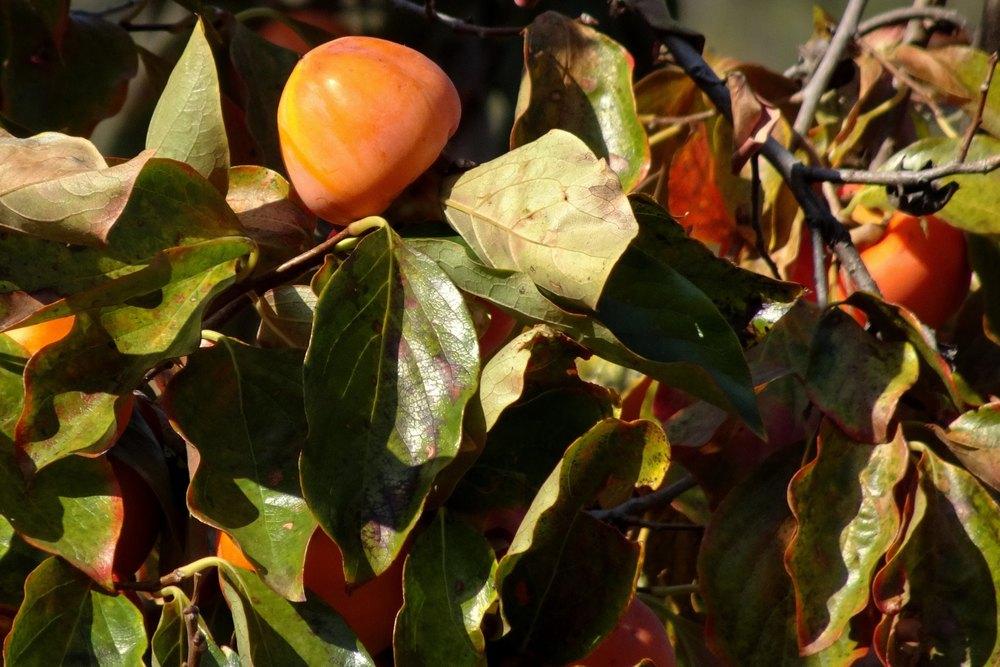
In a more practical vein, the tree is graceful and beautiful all four seasons of the year. It is slow-growing, round-shaped and 15 to 20 feet tall. Smooth, lustrous dark green leaves turn a blaze of orange and red in fall. Branches tend to weep from the heavy fruit load -- be prepared to lend some support with a 2-by-4s. Once leaves drop, the colorful fruits hang more gloriously on the bare branches than any shiny globe on a Christmas tree. Since persimmons have few serious pest and disease problems, this underutilized tree is a prize to grow in any gardener's backyard.
Even if you aren't into the delicious fruits, the persimmon tree has many outstanding ornamental characteristics that still make it the perfect choice as an edible landscape plant. The slow growing, medium-sized persimmon tree has dark green, magnolia-like leaves that turn a brilliant orange-red in fall. The bright orange or red globes of persimmon fruits hang on the tree long after the leaves have dropped, giving the tree a ghostly appearance. The fruits are loaded with iron and vitamin C.
Here's how to grow a persimmon tree in your yard.
Planning
Persimmon trees are hardy in USDA zones 5 to 11. However, you'll have to select the right type for your area. There are two types of persimmon trees. The Asian persimmon (Diospyros kaki) grows in USDA hardiness zones 7 to 11, and is known for its large fruits on smaller trees. It's the type often sold in grocery stores.
The American persimmon (D. virginiana) is a faster growing, larger tree that's hardy to USDA zone 5. It produces smaller fruits, which some consider richer in flavor than its Asian cousins.
Persimmon trees can grow in many regions of the country from New England to California.
Persimmon fruits are grouped as astringent and non-astringent. The astringency is due to tannins that dissipate as the fruits soften. Astringent fruits make your mouth pucker when eaten while still hard, but have a rich, sweet, full flavor when allowed to ripen to a jelly-like consistency. Non-astringent fruits can be eaten when hard or soft. Asian persimmons can be astringent or non-astringent depending on the variety. American persimmons are all astringent.
Here are some varieties to try in your yard.
Nonastringent Persimmons (Edible when either hard- or soft-ripe)
Fuyu- Reddish-orange fruits have a sweet, crisp, mild-tasting flesh. The fruits ripen in midseason and can hold on the tree for up to two months. The trees are hardy to USDA zone 8.
Jiro- These midseason, orange fruits are similar to 'Fuyu,' but are larger with a flattened shape. The trees are hardy to USDA zone 7.
Izo- These early ripening, orange fruits have a sweet, pale orange flesh and are hardy to USDA zone 7. It's well adapted to the Southeast coast.
Astringent Persimmons (Edible when soft-ripe)
Hachiya - These early maturing, large, acorn-shaped, orange-red fruits have a sweet taste and smooth texture. It's a standard variety grown in California and is hardy to USDA zone 8.
Tanenashi - Large, heart-shaped reddish-orange fruits with yellow flesh are produced mid- to late in the season. This variety is good for drying and hardy to USDA zone 7.
Early Golden - Yellowish orange, sweet fruits are early, and grow on a large tree. This is the most widely planted American persimmon, and is hardy to USDA zone 5.
Meader - This early maturing fruit is the hardiest of all American persimmons, it can withstand temperatures to -30° F. Fruits are round, orange, and seedless.
Rosseyanka - This Russian hybrid is a cross between an American and Asian persimmon. It has the leaf and fruit shape of the American type with the fall leaf color and fruit size of the Asian persimmon. It's self-fruitful and hardy to zone 5.
Colorful orange, red, and yellow persimmon leaves in fall make this tree a beautiful addition to any yard.
In spring or fall dig a hole three times wider than the root ball and as deep. Plant the bare root, or containerized persimmon tree, and water.
Prune in late winter removing suckers and opening the tree to have six- to eight-scaffold branches evenly distributed around the tree. Mature trees require little additional pruning. Thin fruits so there are one or two per shoot. Persimmons have few insect and disease problems. Raccoons, birds, and opossums sometime help themselves to ripe fruit. To prevent this, harvest the fruits of even astringent-types when fully colored but still hard, and allow to ripen indoors in a paper bag with a ripe banana.
 Victory Seed Company has all the seeds you want for your best garden in 2024.
Victory Seed Company has all the seeds you want for your best garden in 2024.
For 25 years, the family-owned Victory Seed Company has provided the highest quality vegetable, herb and flower seeds to families across the country. We are passionate about providing you the best seeds available that give excellent germination, robust plants, and the harvest you want. With a catalog of over a thousand varieties, we have everything, and our prices are the kinds that we'd want to pay. We have hundreds of yesterday's heirloom vegetables, as well as today's award winning hybrid selections. Get to know us by visiting our website and browsing through our online vegetable seed catalog.